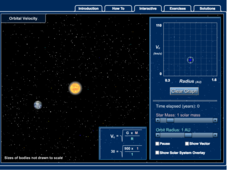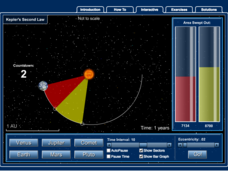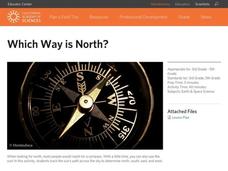McGraw Hill
Orbital Velocity Interactive
Why does it take Pluto 90,000 days to orbit the sun, but it only takes Mercury 88 days? An interactive lesson helps pupils find a connection between the speed of orbit and distance a planet is from the sun. The simulation allows for...
Curated OER
The Moon Orbits the Sun?!?!
Young scholars calculate the strength of gravitational force exerted on the moon by the sun and earth. In this orbital activity students view a demonstration to see the gravitational forces between bodies.
Curated OER
Orbital Bliss
Most young mathematicians are aware that the planets don’t orbit the sun in a circle but rather as an ellipse, but have never studied this interesting feature. This resource looks at the planetary orbits in more detail and helps learners...
Curated OER
Orbital path of Landsat
Students comprehend how Landsat satellites orbit teh Earth to produce images. They comprehend the elliptical path of satellites. Students recognize that a different orbital path is needed for different satellites to perform their tasks....
Curated OER
Target Earth
Space scientists use water displacement to determine the mass of a cubic centimeter mini meteorite, and then use it as a small-scale representative of an asteroid. They figure out the orbital velocity of an asteroid. Then they use a...
Curated OER
Orbit, rotation, revolution of Earth
Eighth graders define orbit, rotation and revolution. They demonstrate the orbit, rotation and revolution of the Earth. Students identify the types of measurements and the instruments that used for orbit, rotation and revolution. They...
Curated OER
Orbiting Satellites
Eleventh graders explore the concept of orbits. In this Algebra II lesson, 11th graders investigate Earth-orbiting satellites as they use algebraic thinking to calculate altitude and velocity.
McGraw Hill
Kepler's Second Law Interactive
Kepler decided to think outside the box and discovered that planets orbit in elliptical patterns. An engaging activity demonstrates the elliptical orbit pattern in relationship to the area of a planet to explain Kepler's Second Law....
McGraw Hill
The Bohr Atom
Elements don't have fingers, but they have fingerprints! An interactive simulation gives young scientists the opportunity to study orbital changes of an atom and the corresponding spectrum reading. They realize how each atom has a unique...
Curated OER
Orbital Mechanics
Twelfth graders examine the misconceptions of Newton's laws of motion. In this motion and gravity lesson students interpret data and see the effects of gravity.
Curated OER
Planetary Orbit
Students compare and contrast ellipses of various eccentricities that represent the shape of planetary orbits. They make a circle with the string by trying the two ends togther. Students calculate the eccentricity of their ellipses by...
Curated OER
Bringing the Solar System to Life
Students walk marked paths as they simulate the orbit of the planets. In this solar system lesson, students recognize the relationship between the sun and the planets. Students visualize how the phases of the moon are seen.
Alabama Learning Exchange
Our Restless Planet
Students examine the topic of the Earth's rotation, revolution, and orbit. They observe teacher-led demonstrations, explore various websites, write journal entries, conduct a demonstration of why Earth experiences day and night, and...
University of California
Seasons Lab Book
Unlock the mystery behind seasonal change with a collection of worksheets and activities. Whether they are drawing pictures of Earth's orbit around the sun or graphing the temperature and daylight hours of different locations from around...
Core Knowledge Foundation
A Time for All Seasons - Summer
The sun is shining and the birds are singing, what better time to teach young learners about the fun season of summer. In this week-long science series, children learn how the rotation and orbit of the earth influence the days and...
Curated OER
Earth, Sun, and Moon
Young scholars participate in a demonstration and complete an online activity that illustrates the earth orbits the sun once a year, and that the moon takes approximately 28 days to orbit the earth.
Curated OER
Orbit an Artificial Satellite
Students construct an artificial satellite from random materials. They demonstrate the principle of an orbit. Students are divided into small groups. Each group creates a model of an artificial satellite in orbit.
McGraw Hill
Kepler's Third Law Interactive
Common sense says that the farther a planet is from the sun, the longer the orbit. Kepler turned common sense into his third law by quantifying this relationship. Classes explore Kepler's Third Law through an interactive tutorial. They...
McGraw Hill
Retrograde Motion
How does Mars move both eastward and westward in Earth's sky? A simple interactive describes the concept of retrograde motion using both color and graphic models. Learners understand that the speed of the orbit accounts for Mars' change...
PBS
Why Do We Have Seasons?
Explore the reason for the seasons! An interactive lesson allows learners to explore the earth's rotation from the viewpoint of four cities at different latitudes. It provides descriptive information at eight points during the orbit...
Purdue University
Global Design for the Seasons
People don't all get the same amount of sun at the same time of the year. Collaborative groups explore how the motion of Earth contributes to the idea in an inquiry-based STEM lesson. Learners first investigate how the rotation of Earth...
California Academy of Science
Which Way is North?
Who needs a compass to find cardinal directions? Just place a stick in the ground and record the movement of its shadow over the course of a day. Then, measure the shadow lengths in order to determine a north-south line. A simple...
Curated OER
Astronomy
Students explore space science by utilizing education software. In this moon cycles lesson, students discuss the importance of the moon and the different phases we observe from earth. Students demonstrate the earth's orbit by creating a...
Curated OER
Earth and Sun's Distance
Students consider the shape of the Earth's orbit around the Sun. They view the first segment of Science Court video and use Timeliner software to construct a scale of the distance between the Earth and the Sun.
Other popular searches
- Earth's Orbit
- Elliptical Orbit
- Planet Orbit Gravity
- Orbital Diagram Atom
- Orbit the Sun
- Earth Orbit
- Space Science Orbits
- Planets Elliptical Orbit
- Earths Orbit
- Orbit Ellipses
- Electron Orbitals
- Orbital Diagram

























